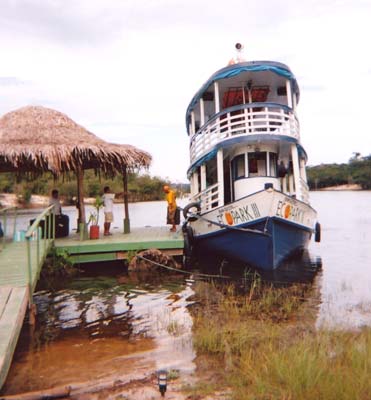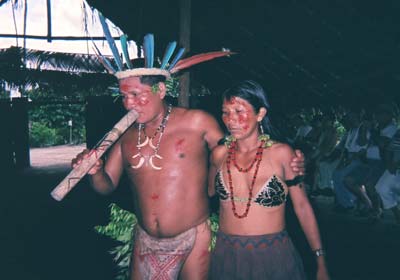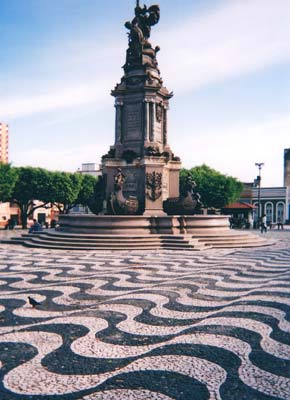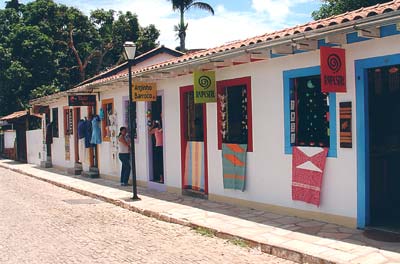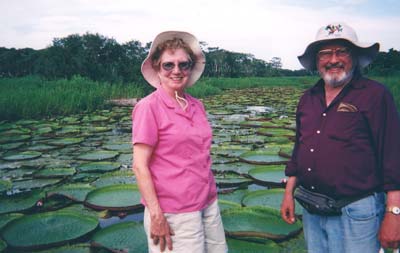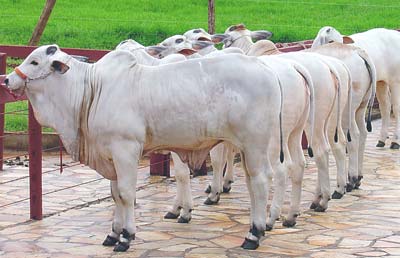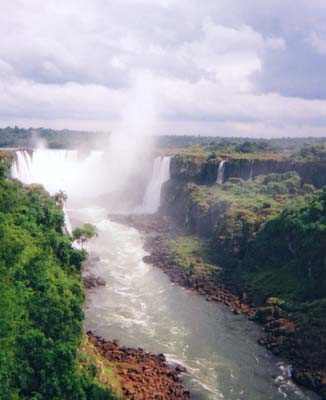Exploring big, beautiful Brazil
by Emilee Hines, Hendersonville, NC
I fell in love with Brazil before we left the airport at Rio de Janeiro. It was mid-January, a bleak time in most of America, but in Rio fields were lush and green and trees were blooming along the streets.
Cariocas, as residents of Rio call themselves, strolled the mosaic sidewalks in sandals and casual summer clothing.
Seeing the sights
Since we had only three days in Rio, we did the touristy but impressive things: visited the Christ the Redeemer statue and Sugar Loaf Mountain, took a general city tour and had lunch at Confeitaria Colombo (Rua Gonçalves Dias, 32), the oldest restaurant in Rio.
Rio has both bus and subway systems, operating from early morning until midnight, so it’s possible to do sightseeing on your own, but for a short visit, when you don’t know your way around, it’s a lot more efficient to take day tours.
Christ the Redeemer, the largest Art Deco sculpture in the world, is 125 feet tall and weighs 1,145 tons. It is reached by a cog railway which runs every half hour through a forested national park. An adult ticket costs 36 reais ($18).
From the upper railway station there are escalators, elevators and steps to the summit. I chose the steps — there were more than 200 of them — and the view was spectacular.
As schools were on holiday, the area was crowded with families enjoying their city’s beauty.
The day we went up Sugar Loaf Mountain, by
a series of cable cars, fog had closed in and obscured much of the view, but off in the distance we could see the head and shoulders of Christ the Redeemer rising above the clouds.
A little R&R
After a city tour of the soccer stadium (Brazil is famous for soccer), the aqueduct, the modern cathedral and the botanical garden, we shopped for gems.
A large percentage of the world’s colored gemstones is mined in Brazil, and one firm, H. Stern, sells a huge amount of them. Stern has a workshop demonstration in their main office in Ipanema (Rua Garcia d’Avila 113), where visitors can watch a jewel develop from a rough stone to a sparkling, many-faceted bauble.
Stern has stores in the large hotels of all the major cities of Brazil and furnishes transportation to its workshop. I bought two rings and received documentation to bring them into the U.S. duty-free.
We could have gone to museums, sporting events or a samba show or on many specialty tours, such as an Afro-Brazilian tour or a Colonial Rio tour. We chose instead to walk on the beach near our hotel, listen to strolling musicians and enjoy the juice from fresh coconuts.
We stayed at the Excelsior Copacabana (Ave. Atlantica 1800; phone 55 21 2545 6000), right on Copacabana Beach. It’s conveniently located near good restaurants, the post office and shopping. Rooms start at $227, double.
We ate outside for only one meal during our stay because the buffet lunches and dinners (39.50 reais, or less than $20) at the Excelsior are so lavish and delicious that locals go there to dine.
Yes, we could have had Châteaubriand for that same price, but the buffet always included hot dishes of beef, shrimp, fish and poultry as well as a cold meat-and-cheese selection plus quail eggs, a wide variety of bread, salads and fruit and waist-popping desserts.
We felt safe in Rio and were told that, because visitors have been warned and are carrying fewer purses and other obvious valuables, theft has dropped sharply. In addition, there is a tourist police station, listed in the booklet “Rio This Month” (available at hotels), which is open 24 hours and is staffed with attendants who speak English and Spanish as well as Portuguese. Travelers can report “document losses, robberies and other occurrences.”
One of the few detractions in Rio, as well as other cities, was extensive graffiti. We were told that it will be cleaned up in time for the Pan American Games, to be held in Rio in July 2007.
Iguaçu
We flew from Rio to Iguaçu Falls, which is three times larger than Niagara, at the junction of Brazil, Argentina and Paraguay. We stayed in the Tropical das Cataratas hotel (phone 55-45-2102-7000, www.tropicalhotel.com.br), located inside the national park. A standard double room cost $230 per night, including breakfast.
From this lovely pink stucco hotel it’s a short walk down a series of steps to the base of the falls. An elevator brings visitors who tire of walking back to street level.
Das Cataratas, which means “the cataracts” or “the falls,” is set in lush gardens. The 210-room hotel has an excellent barbecue buffet (about $20) at night and an ample buffet breakfast in the morning.
Scampering about the grounds are families of coatimundis, animals much like raccoons. It is a protected species, so hotel staff can’t kill the intruders — though they might like to.
One morning at breakfast, a feisty pair of coatis scrambled up onto a table on the patio, just vacated by diners, and began to fight over a yogurt container. Dishes flew and shattered on the tile floor before waiters came to send them packing.
We crossed the border into Argentina, after a lengthy wait, for a look at the Argentine side of the falls.
Small trains carry visitors there from the park entrance. From the train stop, a wooden catwalk spans several of the rivers feeding the falls and terminates in a platform overlooking The Devil’s Throat, the most impressive part of the falls.
Here, two branches of the river tumble over a cut-back lip of rock, throwing up a soaking spray. Advice — take an umbrella or a rain poncho, and have the professional photographer there take your photo.
For about $80, visitors can take the Macuco tour, riding on a wagon, hiking through the jungle and experiencing the falls up close in a rubber boat. I did this tour on an earlier trip to Iguaçu. Or, for the same price, a helicopter will take you over the falls.
Just outside the gate of the national park is the Bird Farm, a huge cage that allows visitors to enter and interact with the birds. The entrance fee is about $10.
For me, the majesty of the falls, especially after they almost doubled in volume following a heavy rain on our second night there, was reason enough to go.
Into the Amazon
We saw São Paulo only on a city tour by bus, as it was the transfer point for our flight to Manaus and, later, to Goiânia. This city of 14 million, with another 14 million in the suburbs, has numerous parks, historic buildings and many skyscrapers. We’ll have to explore São Paulo on another trip.
To experience the Amazon, we stayed at the Amazon EcoPark Jungle Lodge (phone 55 92 9146 0594, www.amazonecopark.com.br), a series of cottages set in the rainforest about 30 minutes by boat from Manaus. The windows were screened (though we saw almost no insects) and could be closed with heavy wooden shutters.
We were awakened at dawn by the cries of birds and howler monkeys and sometimes at night by heavy rainfall.
The “dining room” was open on three sides, and at most meals brilliantly colored parrots came to peck at the plates of the unwary. They especially liked watermelon and French toast.
Brazil is noted for its wonderful fruit, and we had it in abundance throughout the trip but especially at EcoPark Lodge. Several mornings we had omelets, and always we had bacon, manioc, a variety of bread and strong coffee served with hot milk.
Electricity was off for two hours in the morning and again for two hours in the afternoon, but we were usually out exploring at that time.
Our guide, Marco Lima, is a well-educated, passionate advocate of conservation, and he knows the fauna and flora of the rainforest well. As we trekked through the jungle, he’d whistle and we’d hear an answering whistle from a bird or some other creature.
When we visited the monkey rehabilitation center, where captured domesticated monkeys are taught to live in the wild again, monkeys scrambled onto his shoulder or swung down into the wire enclosures to get close to him.
Village visits
We visited two different tribal villages by boat: one on the Rio Negro and the second, Terra Nova, a farming and fishing community, on the Amazon. Here children sold huge fish scales from the pirarucu to be used as nail files.
The earth is so fertile and the rainfall and sunshine so abundant here that farmers harvest 100 crops of lettuce a year and lily pads grow to three feet in diameter.
At the Banya settlement, we saw cocoa pods growing from the trunks of trees and watched manioc being cooked in a huge cauldron and rubber being smoked over an open fire. The Banya, painted and wearing traditional clothing, entertained us with song and dance.
The highlight of the Amazon trip, for me, was seeing the Meeting of the Waters. The Rio Negro flows through forest land and carries dark sediment. The Upper Amazon drops swiftly from Andean snows in Peru and is yellow. The two come together and flow side by side for several miles before they blend to form the mighty river we know as the Amazon.
I also joined the dawn canoe trip to see birds, arising at 5:30 to go out into the morning mist. Others went on a nighttime alligator-spotting excursion and reported seeing a caiman but no anacondas.
Manaus
From the rustic lodge on the river, we took our boat to Manaus to the elegant Tropical Manaus hotel (phone 92 2123 5000, www.tropicalhotel.com.br). The rate was $153 per day, including breakfast. Much as I enjoyed the jungle, I was glad to be able to shampoo and dry my hair and wash out some clothes.
Manaus was the main city of the rubber barons of the 19th century. Fortunes were made here, and a beautiful city was built on the edge of the jungle.
The crown jewel of Manaus is the opera house, Teatro Amazonas, completed in 1896. Its dome is covered in painted ceramic tiles, and the main auditorium is decorated with frescoes and sculptured busts of famous artists and lighted with huge, shimmering chandeliers. The ballroom floor is inlaid with various Brazilian woods that had been taken to Italy and fashioned into the design, then brought back to Manaus and installed.
The main courtyard in front of the opera house is inlaid with imported mosaics.
Several bridges and the main market in town were built by the Eiffel brothers, who built the famous tower in Paris. We walked through the produce market, past huge piles of bananas and other fruit, plus shrimp brought in from the sea, spices, manioc and masses of fish of all kinds.
On the sidewalk, vendors were cooking pasteles, thin pastry rectangles filled with cheese, for about a dollar each. If we hadn’t already committed to a barbecue buffet, I’d have stopped to sample one.
That evening’s buffet included piranha, which was very tasty, as well as grilled beef, lamb and chicken.
The next morning I looked into the Stern store and decided the ring I’d bought in Rio was too small. Stern gave me full credit for it as payment on a larger, more elaborate one made of Brazil’s semiprecious stones: amethyst, peridot, garnet, topaz and citrine.
Historic sites
We flew back to São Paulo, stayed overnight at the Airport Marriott (phone 5511 6468 6999, www.marriott.com) and flew out again early the next morning for Goiânia. We were visiting friends, Idevaldo and Carolyn Silva, who took us touring around the city, a fast-growing metropolis with many parks and streets lined with quaresmeira, trees with purple blooms.
On Sunday we toured Babilônia, a 200-year-old ranch that formerly grew sugarcane. The grinding wheels and cooking pans were still in place.
This was the site of the São Joaquim sugar mill, the largest in the state of Goiás; the estate also produced cotton and flour. In addition to the main house, Babilônia has the original chapel, stables and other outbuildings and has been declared a national historic site.
Babilônia (phone 55 62 9294 1805) offers a brunch in addition to the tour and is open Saturdays, Sundays and holidays from 8 to 5.
Nearby is the town of Pirenópolis, once a flourishing mining town but now a weekend getaway for residents of Brasília. It’s a quaint town with cobbled streets, many restaurants, and shops selling silver jewelry, handmade clothing and handwoven rugs and linens.
We ate lunch at Sio Rosa Cachacaria Bar and enjoyed picanha na chapa, a dish made of grilled steak with onions, tomatoes and manioc pieces (rather like potatoes) and covered with melted mozzarella. At about $15, it was enough for four generous servings.
Both Babilônia and Pirenôpolis can be easily visited on day trips from the capital city, Brasília.
Churrascaria
Back in Goiânia, we had our last Brazilian meal at the Montana Grill (Av. 85, No. 2330; phone 62 3245 1781), a churrascaria, or barbecued-meat restaurant. However, it was far more than that, serving sushi, many varieties of cooked fish, salads and desserts.
In a churrascaria, servers come around to the tables bearing huge skewers filled with meat — a leg of lamb, prime rib, roasted chickens or rump roast. Each diner is given a small plastic coaster, red on one side and green on the other. Red is printed, ‘No thanks,’ and green is printed, ‘Yes, please.’ Whichever side you display tells the server whether you want more.
Sides brought to the table were the same in various restaurants: a dish of French fries, another of fried polenta sticks and a third of fried bananas. The bread I liked, pao de queijo (cheese bread), was available at all meals.
This was a memorable farewell meal — delicious, as always.
Travel tips
Here are a few caveats for traveling to Brazil.
• Visas are expensive and may take six to eight weeks to get. You must have a passport with at least six months left on it as well as proof of having had a yellow fever shot.
• If you choose to take malaria tablets, consider malarone, a daily pill with a much lower dosage than the weekly prescriptions. Two people in our group who were taking the weekly pills became ill.
• Take along washcloths; hotels don’t furnish them.
• Try to get some Brazilian money beforehand, either from your bank or at an international airport.
• If you’re going to the Amazon, take along plastic galoshes to go over your shoes for jungle walks.
• Know that in many places in Brazil, they don’t put toilet tissue down the toilet but in a special wastebasket.
• And you must get used to drinking only bottled water.
I’d go back to Brazil again and would try to get the same guides: Anne Darling from Trafalgar Tours (866/544-4434, www.trafalgartours. com), who we used for all our travel arrangements in Brazil, and Marco Lima at EcoPark Lodge.


